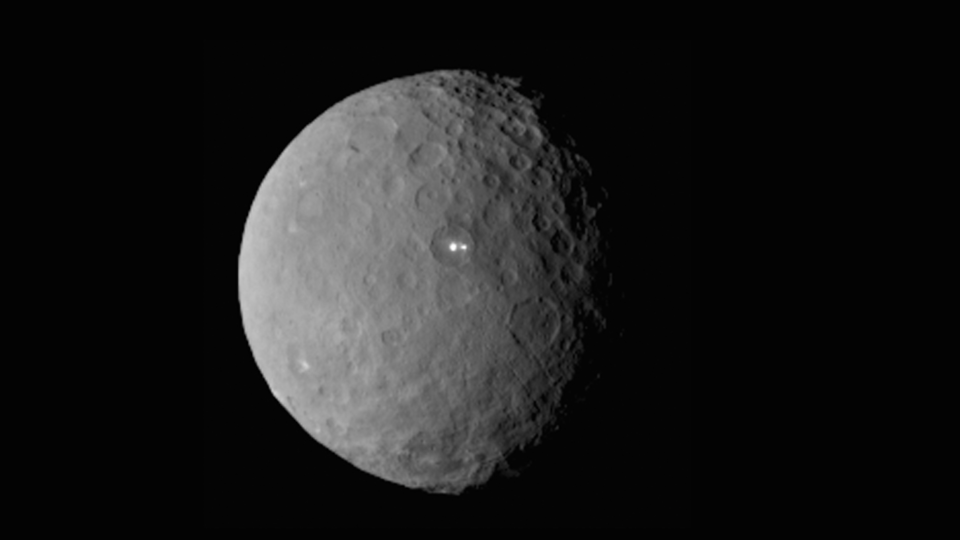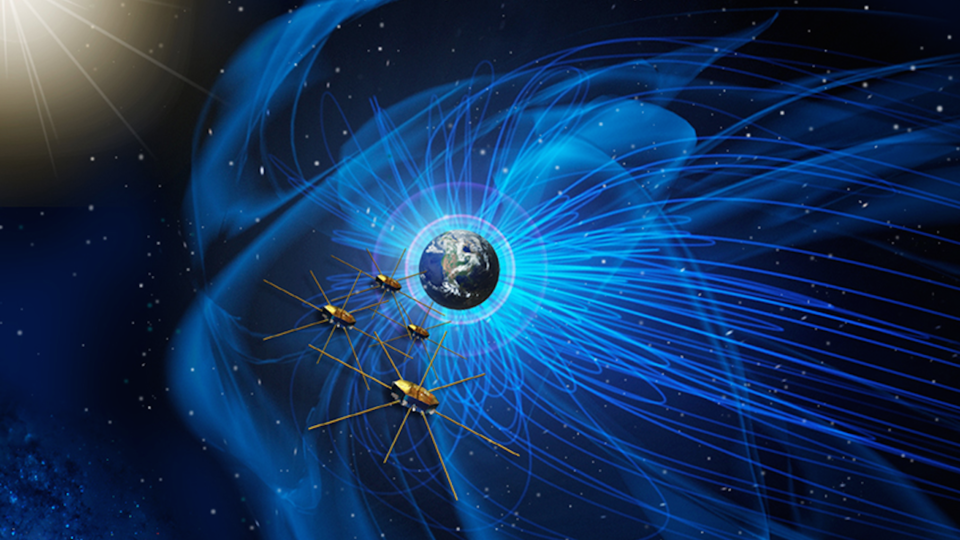Science News
Double Spots on Ceres, Mega Black Holes, and Magnetic Reconnection
Seeing Double...Spots!
About a decade ago, the Hubble telescope first noticed a mysterious, shiny white spot on the dwarf planet Ceres. In January, the Dawn team confirmed the existence of this unexplained feature, estimated to reflect about 40% of the light hitting it (for comparison, on average, the rest of Ceres reflects less than 10% of the light that hits its surface). Now, as Dawn draws ever closer to Ceres and images become more resolved, the spot has yet another surprise—there are two of them!
“Ceres’s bright spot can now be seen to have a companion of lesser brightness but apparently in the same basin. This may be pointing to a volcano-like origin of the spots, but we will have to wait for better resolution before we can make such geologic interpretations,” said Chris Russell from the Dawn mission, based at UC Los Angeles.
Another possible explanation? Ice. Scientists have previously detected water vapor coming from the surface of the dwarf planet, which could create icy patches.
Dawn will enter orbit around Ceres just next week, on March 6, and explore its surface over the next 16 months. As scientists receive better and better views of the dwarf planet, they hope to gain a deeper understanding of its origin and evolution—in much the same way as Dawn explored Vesta, from 2011-2012. –Elise Ricard
Mega Black Hole Detected
This week, a joint team from Peking University in China and University of Arizona announced in Nature that they have detected the brightest quasar in the early Universe, powered by the most massive black hole yet known. And its discovery is raising a lot of questions.
“How can a quasar so luminous, and a black hole so massive, form so early in the history of the Universe, at an era soon after the earliest stars and galaxies have just emerged?” asks the study’s co-author, Xiaohui Fan at the University of Arizona’s Steward Observatory.
The quasar, named SDSS J0100+2802, contains a black hole 12 billion times the size of the Sun that formed about 900 million years after the Big Bang, making it roughly six times as massive as other black holes from its time. The enormous mass of the black hole challenges a widely accepted hypothesis of growth rates.
“Current theory is for a limit to how fast a black hole can grow, but this black hole is too large for that theory,” says Fuyan Bian of Australian National University. This suggests that some supermassive black holes grew much faster than the galaxies they inhabit.
The quasar and its black hole date back to a time close to the end of an important event referred to as the epoch of reionization, marking the end the “cosmic dark ages.” Light from the earliest generations of galaxies and quasars is thought to have transformed the Universe into how we see it today.
Although the quasar was first detected by the 2.4-meter Lijiang Telescope in Yunnan, China, two larger telescopes in southern Arizona, the Large Binocular Telescope (LBT) and the Multiple Mirror Telescope (MMT), were used to determine the distance and mass of the black hole. Observations made with the Magellan Telescope in Chile and the Gemini North Telescope on Mauna Kea, Hawaii, confirmed the results.–Elise Ricard
Magnetic Reconnection
On March 12, NASA will launch the Magnetospheric Multiscale (MMS) spacecraft to study magnetic reconnection—the process in which magnetic fields connect and disconnect with an explosive release of energy.
The mission consists of four identical space observatories that will provide the first three-dimensional view of magnetic reconnection. Because the observatories will fly through reconnection regions in a tight formation, in less than a second, key sensors on each spacecraft are designed to measure the space environment at rates faster than any previous mission.
“Magnetic reconnection is one of the most important drivers of space weather events,” says Jeff Newmark, of the Heliophysics Division at NASA. “Eruptive solar flares, coronal mass ejections, and geomagnetic storms all involve the release, through reconnection, of energy stored in magnetic fields. Space weather events can affect modern technological systems such as communications networks, GPS navigation, and electrical power grids.”
The mission observes reconnection directly in Earth’s magnetosphere. By studying reconnection in this local, natural laboratory, MMS helps us understand reconnection elsewhere, such as the atmosphere of the Sun, the vicinity of black holes and neutron stars, and the boundary between our solar system and interstellar space.
“This is the perfect time for this mission,” says Jim Burch, principal investigator of the MMS instrument suite science. “Studying magnetic reconnection near Earth will unlock the ability to understand how this process works throughout the entire Universe.” –Molly Michelson
Images: NASA

